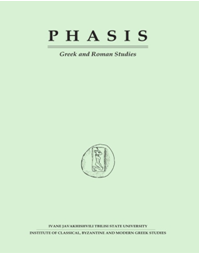The Metamorphosis of Daphnis from Theocritus to Virgil
DOI:
https://doi.org/10.48614/phasis.21.2019.119-139Abstract
The character of Daphnis, who has intriguing significance in folklore and religion, becomes an important literary figure in Theocritus, who, in his narrative of Daphnis’ death, makes him the founding figure of his new genre, bucolic poetry. Theocritus’ successors, Bion of Smyrna in his Adonidis Epitaphium, and the anonymous author of Bionis Epitaphium, refer to Daphnis – inevitably the Theocritean Daphnis – and transform his figure, adapting it to the themes and purposes of their poems. After them, in founding Latin bucolic poetry, Virgil appropriates Daphnis, not only in order to pay tribute to the previous literary tradition, but as a point of departure (and of arrival) in his reflection on bucolic poetry and his relationship with his great Syracusan predecessor. The paper aims to retrace the path of Daphnis, to understand, in the treatment reserved for him by each poet, the elements of vitality and originality that his great inventor Theocritus gave him and that his successors developed at different levels. Virgil, in particular, is able to employ the figure of Daphnis and charge it with a new significance, in order to highlight the great difference between his own poetry and Theocritus’ bucolic production.Downloads
Published
2019-12-16
Issue
Section
Articles
License
Copyright (c) 2019 PHASIS

This work is licensed under a Creative Commons Attribution-NonCommercial 4.0 International License.


